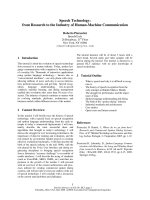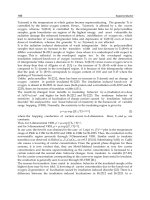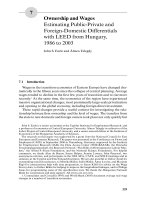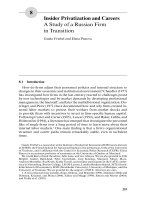From Nuremberg to The Hague - The Future of International Criminal Justice Part 8 potx
Bạn đang xem bản rút gọn của tài liệu. Xem và tải ngay bản đầy đủ của tài liệu tại đây (85.29 KB, 21 trang )
the Appeals Chamber. The Chamber was authorised to
apply international law and the ICTY as an international
court could have refused to act, except as permitted by
international law.
Furthermore, it is easy to see that the International
Covenant does not equate the specific due process stan-
dards with the requirement that a criminal court be
established by law. Those standards are separately
expressed in the Covenant (and in the European
Convention). Under the Covenant, everyone is entitled
in the first place – over and above specific issues of due
process and the right to defend oneself – to ‘a compe-
tent, independent and impartial tribunal established by
law’. A body whose existence was precarious or whose
judges were selected arbitrarily might not meet this
standard, even if the accused had a full right of legal
representation and was not compelled to confess guilt.
To be fair, the Appeals Chamber went on to give
reasons why it could be considered to be established by
law,even in the context of a Security Council resolution,
i.e. an executive resolution.
25
The Security Council did
have power to establish the Tribunal in terms of the
United Nations Charter. The Tribunal’s mandate had
been affirmed and substantial resources for its work
132
25
Prosecutor v. Tadic (Jurisdiction), Appeals Chamber, 2 October
1995, 105 ILR 453 at 465–71 and 474.
provided by the General Assembly; support for the
Tribunal was, if not quite universal, widespread. The
Tribunal was not established only on a temporary basis
but had a long-term mandate in terms of charges of war
crimes in Yugoslavia. Moreover, the support for it was
manifested by national legislation in many countries,
providing for co-operation and supporting the process
of the Court with ancillary national processes.All of this
gave it the combined legitimacy which was associated
with the rule of law,even if it had its origin in a collective
executive resolution of an emergency character.
Thus we can accept the conclusion of the Appeals
Chamber in the Tadic case, if not all of its reasoning. But
it showed that there was a difficulty in creating an inter-
national criminal court, to ensure that international
law’s standards were fully met.
The problem of acceptability of a universal
international criminal court
Above all, perhaps, there was the problem of the accept-
ability of an international criminal court for states.
How would it relate to national criminal courts with
their own jurisdiction over the alleged crimes and the
accused persons? No one defends genocide or the
massacre of civilians in armed conflict. But armed
The drafting of the Rome Statute 133
conflict always produces what NATO spokesmen call
‘collateral casualties’. If drawing the line between legiti-
mate and illegitimate behaviour in wars – international
or internal – was to be practically a justiciable matter, a
matter for criminal courts on a regular basis, then the
relation between national and international jurisdic-
tion would become a very sharp question indeed. Ad
hoc criminal courts were one thing – whether they were
called into being to deal with Nazi or Japanese war
criminals or with generals and militias in the former
Yugoslavia and genocidaires in Rwanda. Such ad hoc
creations were a priori controlled, more or less. They
amounted to international criminal justice for others,
from their inception. But the ICC was – potentially at
least – international criminal justice for ourselves, not
just for others. How could it be controlled?
This was a particular issue for international peace-
keeping operations. Cases had occurred where those
operations were alleged to have involved war crimes;
there were investigations and even trials in Canada and
Belgium.
26
Allegations were made that Western bomb-
134
26
Crimes committed by military personnel during United
Nations peacekeeping operations in Somalia have been dealt
with by military court mar
tial in Canada:
R. v. Brocklebank,
Court Martial Appeal Court of Canada (1996) 134 DLR (4th)
377. Italy and Belgium also instituted inquiries into the conduct
of their military personnel in Somalia: see e.g. the decision of
ing and targeting in Yugoslavia and subsequently
Afghanistan involved breaches of international humani-
tarian law. So these were not just theoretical questions.
Two possible solutions
Faced with these three difficulties in the way of establish-
ing an international criminal court, it was possible to
envisage two broad solutions. One was essentially a
procedural solution. The ICC would in effect borrow its
legitimacy from a national system or systems of interna-
tional criminal justice,acting as surrogate for these, exer-
cising their jurisdiction and applying their substantive
The drafting of the Rome Statute 135
the Belgian M
ilitary Court of 17 December 1997 in
Ministère
public et Centre pour l’égalité des chances et la lutte contre le
racisme v. C … et B …, Journal des Tribunaux, 4 April 1998, p.
286. See also N. Lupi, ‘Report by the Enquiry Co
mmission on
the Beha
viour of Italian Peacekeeping Troops in Somalia’(1998)
1 Yearbook of Inter
national Humanitarian Law
375; R. M. Young
and M. Molina, ‘IHL and Peac
e Operations: Sharing Canada’s
Lessons Learned from Somalia’ (1998) 1 Yearbook of
International Humanitarian Law 362; K. Boustany,
‘Brocklebank: A Questionable Decision of the Court Martial
Appeal Court of Canada’ (1998) 1 Yearbook of International
Humanitarian Law 371; R. C. R. Siekmann, ‘The Fall of
Srebrenica and the Attitude of Dutchbat from an International
Legal Perspective’ (1998) 1 Yearbook of International
Humanitarian Law 301.
law to the extent that the limited rules of international
criminal law did not cover some question. The second
solution was to establish, from the beginning, an essen-
tially autonomous international criminal justice system,
with its own institutions and rules, essentially distinct
from national systems and dependent on them only for
co-operation and enforcement.
In terms of the difficulty outlined above, the proce-
dural model was strongest in addressing the first and,
especially, the third, and weakest in relation to the
second. Conversely, the international criminal justice
system model would address the first difficulty head on,
and in doing so would meet the second. But the more
autonomous and independent the system created, the
more problems one could envisage in terms of its real
acceptability, especially vis-à-vis non-parties. Either the
new system would impose itself on third parties, as
national criminal justice systems do (absent any ques-
tions of immunity such as those raised in the Pinochet
case
27
). Or it would apply only to nationals of states
136
27
Re Augusto Pinochet Ugarte, UK High Court of Justice, Queen’s
Bench Division (Divisional Court), 28 October 1998, (1999) 38
ILM 70; R. v. Bow Street Metropolitan Stipendiary Magistrate, ex
parte Pinochet Ugarte (No. 1), England, House of Lords, 25
November 1998, [2000] 1 AC 61; R. v. Bow Street Metropolitan
Stipendiary Magistrate, ex parte Pinochet Ugarte (No. 3),
England, House of Lords, 24 March 1999, [2000] 1 AC 147.
parties, making the ICC a sort of international criminal
court for the virtuous.
In 1994, the ILC proposed a text essentially reflecting
the procedural model, and its proposal became the
basis for the subsequent negotiations. In the course of
the negotiations, however, the model changed, and in
the Rome Statute and associated documents what has
emerged is, in essence, a separate international criminal
justice system. The drafting of the Rome Statute is the
history of the move from the first to the second model.
The ILC’s procedural model
The ILC’s approach was to create an international
criminal court which would in essence do for states
what they could have done for themselves, having juris-
diction over an accused in respect of some grave crime
under international law. If a particular state party to the
Geneva Conventions of 1949 or to some other interna-
tional criminal law convention had both custody of and
jurisdiction over the accused, that custodial state could
transfer the accused to the ICC – and at the same time
in effect transfer its jurisdiction over the accused. Only
then would the ICC proceed independently, although
probably with the assistance of the ceding state.
Conceptually, the case would proceed on the basis of
The drafting of the Rome Statute 137
the relevant crime under international law, any associ-
ated rules of international law, and the national law of
the state or states where the crime was committed. This
meant it was not necessary for the Statute of the Court
to set out in detail all the elements of the crimes within
its jurisdiction. It was sufficient to identify those crimes
and to leave it to substantive international law, in
conjunction with applicable national law where inter-
national law was silent on some matter, to deal with the
substance. The ICC in this conception was an essen-
tially procedural or remedial device. It did not require
the creation of a new international criminal justice
system, with all that that entailed.
28
Central to the ILC’s text was the idea of complemen-
tarity, a term intended to express the relationship
between the ICC and national courts. There was much
talk at the time of‘subsidiarity’,the concept used in asso-
ciation with the Maastricht Treaty of 1992 to express the
relationship between EU law and national law.
29
It was
138
28
The evolution of the ILC’s model can be traced in its Annual
Reports to the General Assembly from 1992 to 1994: Report of
the International Law Commission on a Draft Code of Crimes
Against the Peace and Security of Mankind, UN GAOR, 47th
Sess., Supp. No.10, UN Doc.A/47/10, pp. 9–33; 48th Sess., Supp.
No. 10, UN Doc. A/48/10, pp. 21–42; 49th Sess., Supp. No. 10,
UN Doc. A/49/10, pp. 23–194.
29
Treaty on European Union, Maastricht, 7 February 1992, 1757
UNTS 3, Preamble. See also A. G. Toth, ‘The Principle of
not appropriate to describe an international criminal
court as ‘subsidiary’ to national courts, but its role was
certainly intended to be secondary. Anyhow, the term
‘subsidiarity’was already taken,so ‘complementarity’was
used. It was useful in explaining to governments the
limited role the ICC was intended to have, and in that
sense it addressed the third, political problem described
already. But its main function was in relation to the first
problem,the underlying institutional issue.The ICC was
essentially a guarantor of state compliance with the obli-
gation to investigate credible allegations of war crimes
involving persons on its territory. Referred to as the aut
dedere aut judicare principle, that obligation requires
states either themselves to try, or to extradite to some
other requesting state for trial, persons found to have a
case to answer for the relevant international crime. The
ICC became an alternative forum for transfer, but the
assumption was that in most cases the custodial state
would proceed to trial itself.Any party to the ICC Statute
The drafting of the Rome Statute 139
Subsidiarity in the Maastricht Treaty’ (1992) 29 Common
Market Law Review 1079. The principle of complementarity was
emphasised in the preamble to the ILC’s Draft Statute for an
International Criminal Court, UN GAOR 49th Sess., Supp. No.
10, UN Doc. A/49/10, pp. 43–160: ‘[The international criminal
court] is intended to be complementary to national criminal
justice systems in cases where such trial procedures may not be
available or may be ineffective.’
could trigger the aut dedere aut judicare obligation by
making a complaint, which the Prosecutor could then
take up.
This approach allowed the ILC to provide that state
consent was the underlying basis of jurisdiction. Since
the point of the Statute was to get custodial states to
comply with their own existing obligations under
international criminal law treaties, and since they
could do so without transferring the accused for trial at
the international level, it was not necessary to compel
them to do so. Their consent to an international trial
(and also the consent of the state where the crime was
committed, i.e. the territorial state) was required. This
powerfully met the third difficulty I have identified.
States could become parties to the Statute without any
ultimate commitment to agreeing to an international
trial. They could support the international system in a
range of ways while preserving their own jurisdiction
with respect to persons subject to it. Not for the first
time in international law, the text aimed at universali-
ty rather than the adoption of a system of compulsory
jurisdiction.
There were, however, two exceptions to this principle
of consent. First, the Security Council acting under
Chapter VII of the Charter could override any consent
required and submit a case or class of cases falling
140
within the Statute to the ICC.
30
Such a decision would
of course be subject to the veto. It was an essential
element in order to deter the creation of still more ad
hoc tribunals for international crimes. In effect the 1994
Draft Statute institutionalised (and thus removed the
need for) any further ad hoc criminal tribunals being
created by the Security Council, thereby at the same
time addressing the rule of law problem and attempting
an end-run around Chapter VII as a constitutional basis
for criminal jurisdiction. Under the proposed Statute,
international criminal jurisdiction was not created by
an emergency executive resolution; it existed already,
and was given effect by the implementing laws of the
state parties. But the exercise of jurisdiction was trig-
gered by the Security Council – an appropriate role in
respect of situations covered by Chapter VII.
The second exception concerned the crime of geno-
cide. The ILC’s Draft Statute gave the proposed court
‘automatic’ jurisdiction over genocide, independently
of the consent of the custodial or any other state.
31
This
reflected the cardinal character of genocide as the ‘worst
of crimes’. From a technical point of view, it was justi-
fied by the fact that the Genocide Convention did not
confer any form of extraterritorial jurisdiction over
The drafting of the Rome Statute 141
30
ILC’s Draft Statute, Articles 23(1) and 25(4).
31
Ibid., Articles 20(a), 21(1)(a) and 25(1).
genocide, so that a state with custody of a person credi-
bly accused of genocide in some other state apparently
had no choice but to return the accused to the territorial
state (which might be a step towards impunity) or to
transfer him or her to the ICC. That choice was already
reflected in Article VI of the Genocide Convention, as
noted already. Thus the exception could be justified in
terms of the existing law. But in substance it was a
reflection of a view within the ILC that the complemen-
tarity approach was too pervasive and involved too
many concessions to state sovereignty.
On the other hand, precisely because it relied on
consent, complementarity and pre-existing interna-
tional criminal law, the ILC’s Draft Statute could accept
a broader range of subject-matter jurisdiction. There
was no need to limit the ICC to the Nuremberg crimes
of aggression, war crimes and crimes against humanity
(including genocide) – two of which were anyway
undefined or only partially defined in international
instruments. Experience – for example, with the
Noriega affair and the Lockerbie bombing – showed
that other crimes could have a pronounced interna-
tional dimension and could be appropriate for an inter-
national criminal court. Thus the ILC’s text extended
jurisdiction over all the crimes defined by international
treaties in force, and made provision for new treaty
142
crimes to be added. It defined those crimes not
autonomously but by reference to their definition in
existing international law, thereby avoiding the need for
an extensive new exercise in drafting. Instead of a juris-
dictional bar (to avoid ‘run-of-the-mill’ treaty crimes
coming before the ICC), there was an admissibility
threshold, applied by the Prosecutor and reviewed by
the Court and linked to the principle of complemen-
tarity.
32
Only cases of major significance, which could
not be dealt with at the national level, would come to
the ICC.
One of the major criticisms made of the ILC’s model
was that it gave no independent investigatory role to the
Prosecutor, prior to the referral of a case and independ-
ently of the consent of the states concerned. Only once
the pre-conditions for the exercise of jurisdiction were
met could the Prosecutor act with full autonomy. This
was certainly a deficiency; it was a concession to the
The drafting of the Rome Statute 143
32
Ibid., Article 35. The pr
inciple of complementarity is also
central to the determination of
admissibility under Article 17 of
the Rome Statute. See further, J. T. Holmes,
‘The Principle of
Complementarity’, in R. S. Lee (ed.), The International Criminal
Court: The M
aking of the Rome Statute: Issues, Negotiations,
Results (Kluwer Law International, The Hague, 1999), p. 41; J. T.
Holmes,‘Complementarity: National Courts Versus the ICC’, in
A. Cassese, P. Gaeta and J. R. W.D. Jones (eds.), The Rome Statute
of the International Criminal Court: A Commentary (Oxford
University Press, Oxford, 2002), p. 667.
concern expressed by some states that an independent
Prosecutor with a roving commission to investigate
international crimes would involve too great an
infringement of sovereignty, even if the Prosecutor
could not initiate a trial at the international level with-
out the relevant consents. But it was an independent
concession, which was not required by the complemen-
tarity model. The trigger for the aut dedere aut judicare
obligation could just as well come from an interna-
tional prosecutor as from a third state.
Overall, as this point showed, the ILC’s Draft Statute
of 1994 made major concessions to national jurisdic-
tion in the interests of maximising support for the
controversial idea of an ICC. Indeed, the principal point
of the exercise was to get the idea of an ICC Statute to
the stage of active discussion in a diplomatic forum.The
kinds of objection to the ICC since made by the United
States were not hard to predict; what was hard was to
assess how the majority of states would respond to
them. A very ambitious conception of an ICC might
have joined the large pile of rejected proposals (going
back to the 1930s). In case of doubt, therefore, the third
problem, that of political acceptability, trumped the
first and the second: it would be a matter for states to
assess the possibility of further steps forward, assuming
that the matter would be actively discussed at all.
144
The Rome Statute: an international criminal justice
system for a few crimes?
I still believe that nothing more ambitious than the
ILC’s Draft Statute could have got on to the agenda in
1994, such was the combination of history, ennui and
professional disbelief. Yet it is remarkable how rapidly
the situation changed.A number of factors combined to
produce the change. An obvious one was the enormous
and increasing support given to the ICC idea by non-
governmental organisations, which had previously
been almost silent. A less obvious factor was the estab-
lishment of not one but two ad hoc tribunals under
Chapter VII of the Charter. On the one hand, there were
concerns as to the possible proliferation of criminal
tribunals created ad hoc, and there was scepticism at the
idea that a criminal tribunal could substitute for effec-
tive political and military measures to deal with a
Chapter VII situation. On the other hand, the Security
Council had shown that the apparently impossible was
achievable. International criminal tribunals could be
created and could function. A neglected factor was the
increasing role of justice ministries in the negotiations.
These delegates brought a range of professional
concerns about the actual functioning of an ICC and its
interaction with national legal and constitutional
The drafting of the Rome Statute 145
systems. To a certain extent, this cut across more tradi-
tional foreign affairs concerns as to loss of sovereignty
and the paramountcy of inter-state relations.
Many of the provisions which emerged in the Rome
Statute do not pertain to the choice between models of
ICC jurisdiction, and do not need discussion here. For
example, both the ILC’s Draft Statute and the Rome
Statute prohibit judges who have served a full term
from being re-elected,
33
a provision which should
probably be applied to all full-time international
tribunals. Both texts provide for the ICC to consist of a
mixture of judges with criminal trial experience and
qualifications and those experienced in international
criminal law and/or human rights.
34
In a number of
respects the Rome Statute made independent improve-
ments. There is now a more pronounced emphasis on
gender equality
35
and on provisions for the compensa-
tion of victims;
36
in both respects, the Rome Statute is a
clear advance on the ILC’s Draft Statute.
For present purposes, however, I need to mention
four issues which did pertain to the choice between
models, and to compare the solutions proposed by the
ILC with those finally adopted.
146
33
ILC Draft Statute, Article 6(6); Rome Statute, Article 36(9).
34
ILC Draft Statute, Article 6(1); Rome Statute, Article 36(3).
35
Rome Statute, Article 36(8).
36
Ibid., Articles 75 and 79.
Consent, complementarity and the ‘ownership’ of
crimes From a fairly early stage in the negotiations in
the Preparatory Commission, the idea of optional juris-
diction was virtually excluded. The majority agreed that
states parties to the Statute should by virtue of their
participation be treated as having accepted the jurisdic-
tion of the Court. Under Article 12, the Court may exer-
cise its jurisdiction provided that either the state of the
accused’s nationality or the state on whose territory the
alleged crime was committed are parties to the Statute,
or (if they are not parties) if either of them has accepted
its jurisdiction ad hoc. By contrast, the custodial state
has no specific role in determining jurisdiction.
Under this system, the requirement of separate
consent to jurisdiction is removed for states parties to
the Statute. Even with respect to states not parties, their
lack of consent is irrelevant to jurisdiction, provided
that either the state of the accused’s nationality or the
state on whose territory the crime was committed are
parties. In this important sense the jurisdiction of the
ICC is general and automatic.
As a corollary, the principle of complementarity has
no effect in determining the existence of jurisdiction.
To that extent it is reduced in significance, although it
retains its force in terms of the exercise of jurisdiction.
(The ILC’s Draft Statute gave effect to it at both levels.)
The drafting of the Rome Statute 147
As a further corollary, any state party to the Statute can
refer a possible crime to the Prosecutor, irrespective of
any lack of contact between the referring state and the
crime.
37
Thus no state party has a veto over prosecution, and
the consent even of non-parties may be irrelevant with
respect to crimes committed by their nationals abroad.
To compensate for the reduction in the legal significance
of the principle of complementarity at the level of juris-
diction,complementarity is given enhanced significance
at the level of admissibility. The Preamble emphasises
that ‘the International Criminal Court under this Statute
shall be complementary to national criminal jurisdic-
tions’; complementarity is also mentioned in Article 1.
The principle of complementarity is to be given effect by
the Prosecutor in deciding whether to take forward an
investigation, and by the Court in deciding whether to
authorise a prosecution.A case is only admissible before
the ICC where no state with jurisdiction over the crime is
willing and able genuinely to carry forward the investi-
gation (Article 17). On the other hand, it is a matter for
the Court to determine admissibility; an investigating
state can call upon it to do so but cannot predetermine
the result (Article 18).
148
37
Ibid., Article 14.
Thus states, whether parties or non-parties, may
influence decisions on admissibility by diligently inves-
tigating such crimes themselves. But they do not have
ultimate control over prosecution of their nationals for
crimes committed abroad. On the other hand, except
in cases where the nationals concerned are covered by
some immunity (e.g. as diplomats or members of visit-
ing armed forces), such ultimate control has never
existed vis-à-vis national courts of third states.
Moreover, while the Statute follows general interna-
tional law in specifying that the official position of an
accused, even as a head of state, is not a bar to the exer-
cise of jurisdiction (Article 27), it also specifies that a
request for surrender or co-operation may not be
made if it would ‘require the requested State to act
inconsistently with its obligations under international
law with respect to the State or diplomatic immunity
of a person or property of a third State’ (Article 98).
Since there can be no trials in absentia, this makes it
much less likely that serving officials of non-party
states will come before the Court. But this is only
legally excluded for those senior officials who stay at
home.
The independent Prosecutor Both the ILC’s Draft
Statute and the Rome Statute provided for an indepen-
The drafting of the Rome Statute 149
dent Prosecutor to conduct actual prosecutions. But the
Rome Statute also gives the Prosecutor authority to
investigate suspected crimes within the Court’s jurisdic-
tion without seeking any prior approval.‘The Prosecutor
may initiate investigations proprio motu on the basis of
information on crimes within the jurisdiction of the
Court’ (Article 15(1)). This is a major step forward, as
already noted. But it is even more significant when it is
combined with the abandonment of any stringent
consent requirement on the part of states as a condition
for the existence of jurisdiction. Vis-à-vis states parties to
the Statute, as well as third states in certain cases, the
Prosecutor will in principle be able to decide which
crimes warrant preliminary investigation. Further and
more detailed investigation requires the approval of a
Pre-Trial Chamber, but again states, parties or non-
parties, have no veto at this stage.
The scope of jurisdiction In both these respects –
the abolition of consent requirements and the inde-
pendent powers of the Prosecutor – the Rome Statute
is a significant step towards something which can be
described as an international criminal justice system.
On the other hand, there has been a significant reduc-
tion in the subject-matter of that system, i.e. in the
crimes which fall within the Court’s jurisdiction,
150
particularly as compared with the ILC’s proposals.
First, certain more or less temporary limitations
should be noted.
Under Article 5(2), jurisdiction may not be exercised
over the crime of aggression until the states parties have
agreed on a definition of that crime and on modalities
for the exercise of jurisdiction. The ILC had more
simply proposed that no prosecution should be
commenced for the crime of aggression unless the
Security Council had first determined, in the exercise of
its express power in Article 39 of the Charter, that the
state concerned has committed aggression. The ILC’s
proposal was permanent in effect, whereas (unless it is
adopted as a modality under Article 5(2)) the issue
under the Rome Statute is likely to return to trouble the
states parties.
In addition, Article 124 allows states parties to
exclude war crimes committed on its territory or by its
nationals from the Court’s jurisdiction for a period of
seven years. This bizarre exclusion of course had no
parallel in the ILC’s Draft Statute. It would appear to
override the general requirements for jurisdiction
under the Statute and to operate as a guarantee: in a
case covered by a declaration under Article 124, the
fact that some other state party concerned has not
made such a declaration (e.g. the state where the
The drafting of the Rome Statute 151
crime was committed) would seem to be irrelevant.
38
Of more long-term importance, and of more direct
relevance to my theme, is the overall limitation of the
Court’s jurisdiction produced by Article 5. Jurisdiction
is limited to four crimes: genocide, crimes against
humanity, war crimes and (with the suspensive proviso
noted already) the crime of aggression. It is a remark-
able feature that the ICC’s subject-matter jurisdiction
began as a longish list of crimes defined by existing
treaties in force, and ended as a detailed specification of
a few crimes under international criminal law, without
explicit reference to any existing treaties. The Rome
Statute thus limits jurisdiction to only a few crimes, but
redefines those crimes in detail. In effect, the Rome
Statute is a new – but limited – code of international
criminal law. It is true that, in many respects (especially
in the case of genocide and international war crimes) its
provisions follow, more or less verbatim, the language
of the earlier conventions. On the other hand, they
substantially develop the field of crimes in internal
armed conflict, and, as to crimes against humanity, they
constitute the very first authoritative treaty definition.
Moreover, even in relation to the definitions which are
152
38
It is an open question whether the same analysis applies to new
parties acceding after the entry into force of the Statute (Article
11(2)).









